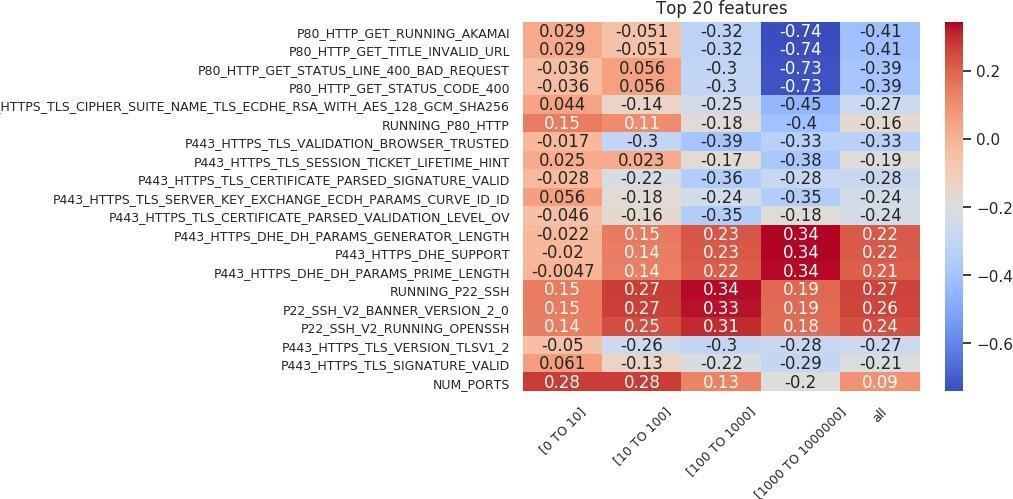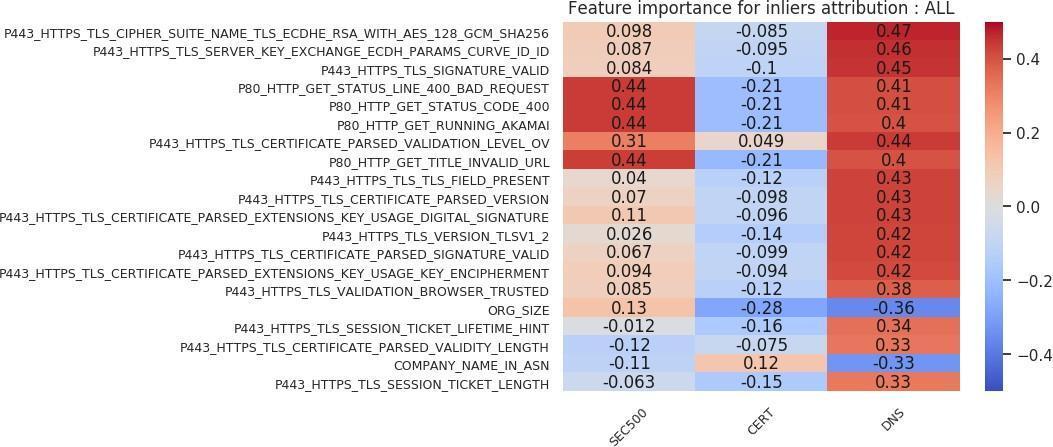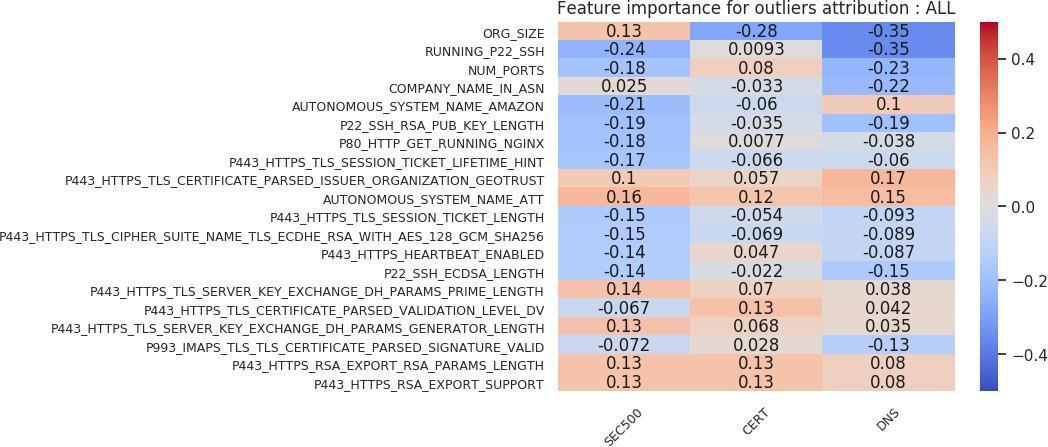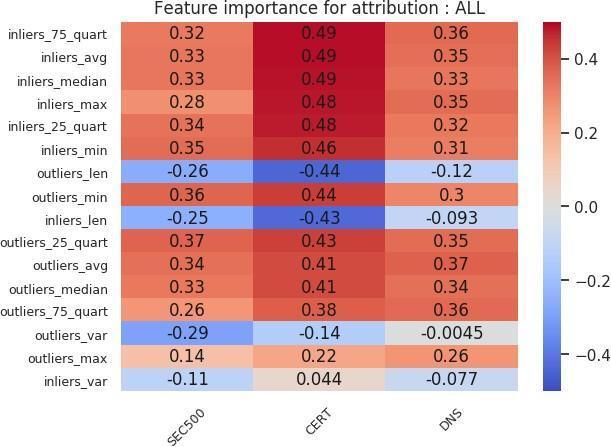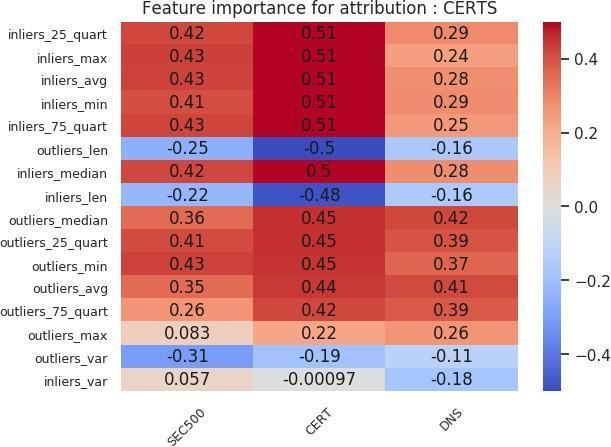1. INTRODUCTION
1.1. Motivation and background
As the cybersecurity threat landscape evolves, malicious security incidents continue to exact a high price on organizations with a public-facing Internet presence, which includes almost all organizations. The breach database maintained by Privacy Rights Clearinghouse, a nonprofit organization that records data breaches, contains 2,717 records of hacking- or malware-related incidents between January 2005 and July 2019. According to the database, those incidents disclosed more than 8.2 billion sensitive records (PRC 2019). The average cost of a data breach to victim organizations was estimated at $3.92 million for 2018 (IBM and Ponemon Institute 2018).
The Ponemon Institute and Accenture put the total value at risk from cybercrime at US$5.2 trillion over the 2019–2023 timespan (Accenture 2019). The enormous cost of risk from cybercrime motivates our approach: to analyze publicly accessible system configuration data that correlate with security incidents and to develop a method for identifying factors that can serve as a basis for quantifying this type of cyber risk.
Figure 1 shows the two network segments (Internet-facing and private) for a given organization. We analyze external network posture, which is accessible by anybody with an Internet connection. External network security posture, at a high level, consists of configurations for different protocols, including the port and service behind the protocol, the version of the service, and many other details regarding the state of such external hosts.
The advantage of our using the external network is that it makes a great deal of information publicly available and does not require information from inside the organization. Hence, it makes it relatively informative and easy to acquire at scale.
We investigate the extent to which system configuration data can be used to predict the likelihood of a security incident by carefully collecting a group of victim organizations (each of which has reported a security incident) and nonvictim organizations (none of which has reported a security incident) and comparing their external system configuration data (Figure 2).
We hypothesize that the configurations relate, in varying degrees, to the occurrences of hacking or malware incidents. This relationship exists either directly—through evidence that attackers exploited a vulnerability appearing in the external system configuration data—or indirectly—through lack of adequate internal policy and implementation of controls to protect the organization’s assets. The assumption that company culture is correlated with the external system configuration is consistent with previous works. Zhang et al. (2014) and Y. Liu, Sarabi, et al. (2015) have shown that misconfigurations can lead to malicious attacks and can be used to predict security incidents with high positive predictive value. We extend their research using heterogeneous data, holistic methods of host representation, and novel machine learning algorithms. In addition to this, the loose coupling of public data and technique affords readers the ability to apply the methods we describe to other similar data sets. The intuitive statistical concepts and analytical methods our approach uses can easily be used for other cyber risk analyses.
1.2. Cybersecurity primer
This section consists of a brief primer for the more complex ideas presented throughout the rest of the paper.
A computer network is a collection of computers that are connected and share information. A service is an application running a protocol on a computer port, where a protocol is a set of procedures that govern communication in a network and a port is a number between 0 and 65535 that uniquely identifies the service. For example, A file transfer protocol (FTP) service is handled on TCP port 21, and its data transfer can use TCP port 20 as well as dynamic ports depending on the specific configuration.
An organization’s domain is a label that identifies a group of computers (both internal and external) belonging to the organization, e.g., drexel.edu. A subdomain is a label that describes a smaller group of computers belonging to a domain or another subdomain, e.g., www.drexel.edu. The Domain Name System (DNS) converts the domain and subdomain names to corresponding Internet Protocol (IP) addresses and vice versa. A digital asset, in this context, could be an IP address, a domain name, a subdomain name, or the host (computer) behind the IP address that belongs to a particular organization. On-premises assets refer to workstations and servers that an organization maintains itself, while cloud-hosted assets are assets managed by a cloud provider (e.g., GoDaddy, Amazon). The organization size is the number of Internet-facing or publicly exposed hosts for an organization.
Footprinting (e.g., subdomain enumeration) and Internet scanning are reconnaissance processes used to identify hosts, and their network services, that belong to an organization. Services running a misconfigured or vulnerable application on the public Internet provide a typical avenue for a threat actor (e.g., malware) to infiltrate a company’s network, which often leads to a security incident.
A security incident is an act of violating an explicit or implied security policy. Essentially, it is an event that indicates an organization’s information technology (IT) system may have been compromised. A data breach is a security incident in which sensitive, protected, or confidential data are copied, transmitted, viewed, stolen, or used by unauthorized individuals. A victim organization is an organization that has reported a security incident (or data breach). On the other hand, a nonvictim organization is an organization that has not published a security incident. A cohort, within this context, is a collection of victim and nonvictim organizations.
With the analysis in this paper we hope to (1) introduce a novel technique of classifying victim and nonvictim organizations (Section 4.1), (2) identify the criterion that best discriminates between those two classes (Section 4.3), and (3) gauge and compare the performance of the model (Sections 4.2, 4.3, and 5.2). For a longer, more detailed list of cybersecurity terms, please refer to the glossary at the end of the paper.
1.3. Related studies
Durumeric, Wustrow, and Halderman (2013) introduced a tool called ZMap that can be used to scan the public IPv4 (Internet Protocol version 4) space (about 4.2 billion IP addresses) in under an hour. Censys (Durumeric et al. 2015) is a search engine and data processing facility built on top of ZMap that collects structured Internet data every 24 hours. We leveraged Censys (2019) in our analysis to obtain accurate and timely data about the configurations of organizations.
Zhang et al. (2014) and Y. Liu, Sarabi, et al. (2015) conducted separate but related studies with a very similar motivation to our work. Zhang et al. (2014) analyzed the extent to which network mismanagement relates to maliciousness. They show a statistically significant positive correlation (0.64) between mismanagement and maliciousness. They also show that an inferred causal relationship exists between mismanaged networks and labeled malicious systems. Y. Liu, Sarabi, et al. (2015) aimed to proactively predict security incidents—e.g., of the sort that Verizon reports in its annual Data Breach Investigations Reports—using externally observable properties of an organization’s network. Their feature space consists of a diverse set of 258 externally measurable features of a network’s security posture. Among those features are one organization size feature, five misconfiguration features, 180 raw time series maliciousness features, and 72 analyzed time series maliciousness features. These are measurements of malicious activities seen to originate from the network. Their results outperform results to date with a 90 percent true positive rate, 90 percent accuracy, and a 10 percent false positive rate.
Our work is different from the aforementioned analyses in the following ways. First, we use a feature extraction engine that provides more than 1,386 features across 26 protocols, providing a richer feature space. Second, whereas Liu et al. utilized reputation blacklists in their analysis, we do not because it introduces a dependency for external security researchers to report malicious IP addresses. Moreover, such lists would need to be updated frequently to maintain accuracy. Lastly, in Liu et al.'s asset attribution step, they map an organization reported in an incident to a set of IP addresses through a sample IP address of the organization involved in the incident. However, that approach is prone to the introduction of attribution errors due to the large number of IPs controlled by public cloud providers. In our analysis, we attempt to improve upon that method by including contemporary reconnaissance tactics (McClure, Scambray, and Kurtz 2001; Roy et al. 2017; Hassan and Hijazi 2018), in combination with manually verified American Registry for Internet Numbers (ARIN) lookups of digital assets. This modification allows us to locate IP address blocks under multiple owner IDs, and effectively map them to the same organization, much like a contemporary attacker would.
In addition to the aforementioned works, some other malicious activity prediction studies are as follows:
-
Sarabi et al. (2015) examined the extent to which an organization’s business details can help forecast its risk of experiencing different types of data incidents. They show that it is difficult to assert, with certainty, the types of incidents a particular organization is likely to face.
-
Y. Liu, Zhang, et al. (2015) applied a support vector machine to a set of reputation blacklists to generate predictions for future security incidents that may happen to a network.
-
Soska and Christin (2014) apply machine learning to predict whether a website may turn malicious and show that their method can achieve a 67 percent true positive rate and a 17 percent false positive rate.
1.4. Problem definition and scope
As mentioned earlier, our goal is to propose a system of security posture–based forecasting by profiling network configurations that are associated with victim organizations. To that end, we employ a numeric interpretation of the configurations for such systems. We then set up a machine learning problem using the configurations as features and the report label as the target. These raw feature vectors compile down to the organizations’ risk vectors. The risk vectors then predict whether an organization will experience a security incident.
Our scope does not include performing any of the following (similar to previous works, such as Sarabi [2018] and Y. Liu, Zhang, et al. [2015b]):
Intrusion point detection. In this work, we do not aim to identify vulnerabilities in Internet hosts, nor do we attempt to uncover possible attack vectors used by malicious agents. Despite that fact, our results and previous works (Sarabi 2018; Y. Liu, Zhang, et al. 2015) reveal that inadequately managed systems have noticeably high degrees of correlation with organizations that report security incidents.
Collection of measurements. This work brings together analyses from numerous data sources, but other than digital footprinting, it does not conduct novel measurements—that is, we do not scan the organizations’ network ourselves.
Use of internal data. We do not analyze cyber insurance applications, internal application logs, or any other information that is not available to an external attacker. Instead, our analysis focuses on outside-in data, i.e., the external network configurations of an organization.
1.5. Contributions
Current work, both in academia (Aditya, Grzonkowski, and Le-Khac 2018; Y. Liu, Zhang, et al. 2015; Zhang et al. 2014) and in the industry (FICO; BitSight [https://www.bitsight.com/]; Security Scorecard [https://securityscorecard.com/]) makes use of a similar pipeline for collecting information about organizations, forming the risk vectors, and analyzing the most effective discrimination rules (Sun et al. 2019). In that pipeline (Figure 2), a set of victim and nonvictim organizations is first identified. That step is followed by attributing their digital assets and configurations on those assets. The configurations are then compared to identify the rules that provide the best discrimination. Using Figure 2 as a starting point, we contribute to the general pipeline in the following ways (Figure 3).
-
Heterogeneous nonvictim collection. To provide an accurate analysis of victim organizations, we compare victims against a set of nonvictim organizations. To avoid selection bias, we collect nonvictim organizations using three different methods (described later).
-
Improved asset attribution. Footprinting is the process of identifying the assets of an organization. Since there is no single “ground-truth” data source of external asset ownership and digital asset usage on the public Internet, we use contemporary reconnaissance tools to attribute digital assets, in much the same way an attacker would.
-
More holistic host representation. Recent studies (Y. Liu, Zhang, et al. 2015; Zhang et al. 2014) rely on a feature space of some 260 or fewer features. Our feature space spans 1,386 features, representing more detailed configuration data from the hosts. This expanded feature space affords us the ability to conduct our analysis at a higher resolution than previously possible.
-
State-of-the-art machine learning for outlier detection. Our work applies an isolation forest (an outlier detection algorithm) to the problem domain to identify system configurations of interest. Such an outlier detection algorithm allows us to effectively reduce the data space to a set of hosts that is about 12 percent of the original size while achieving an incident prediction accuracy of 0.73 ± 0.06, an F1-score of 0.73 ± 0.06, and a false positive rate of 0.25 ± 0.10.
1.6. Outline
The rest of this paper is structured as follows. In Section 2, we discuss the cyber risk and insurance dimensions of the work. Section 3 describes the data pipeline (gathering the network information from Censys and extracting the features from the hosts). In Section 4, we analyze the data by setting up the classification problem, selecting the system configurations of interest, and generating the feature importance charts. Finally, Section 5 concludes the analysis and lists some avenues for future work.
2. CYBER RISK
2.1. Definition
Our goal is to provide a method of determining the probability of a cyber incident with the highest possible confidence. Cyber risk, within the realm of cyber insurance, is often presented in terms of the likelihood that a given organization will experience a cybersecurity loss event multiplied by the magnitude of that cyber loss event, that is,
\[R = P*M,\]
where is the cyber risk, is the probability of a cyber event, and is the magnitude of the loss. For this discussion, however, we exclusively consider the likelihood of the cyber loss event portion of cyber risk. Although the different types of cyber loss events number in the dozens, we focus on cyber losses stemming from remote attacks against Internet-connected computer systems or networks. We also define a cyber risk vector as a numerical representation of this cyber risk. Hence, the (cyber) risk vector is built from data about organizations’ external system configurations.
2.2. Cyber insurance
Cyber insurance underwriters frequently use industry class (finance, retail, healthcare, education) in addition to gross revenue and the number of data records held to evaluate cyber risk. Underwriting evaluations also rely on the use of data from insurance applications that prospective customers fill out. Today, automated cyber risk analyses using external system configuration data are available from several companies, including FICO Enterprise Security Suite, BitSight, SecurityScorecard, and UpGuard.
FICO’s Cyber Risk Score (https://cyberguide.advisenltd.com/fico/) relies on a diverse set of Internet-scale security signals to determine an organization’s risk profile. This information is then used to train a machine learning model that produces a risk score that forecasts the likelihood of a future breach event. SecurityScorecard analyzes the cyber risk of an organization using outside-in data. The platform gathers security data and grades organizations from A to F across 10 security categories (web application security, network security, endpoint security, DNS health, patching cadence, hacker chatter, IP reputation, leaked credentials, social engineering, and cubit score). Their goal is to discover organizations’ external security posture from the perspective of a hacker, business partner, or customer. BitSight uses externally observable data on compromised systems, security diligence, user behavior, and public disclosures to compute an organization’s security rating. BitSight’s security ratings consist of event data and diligence data. Whereas event data comprise evidence of botnet infections, spam messages, malware servers, unsolicited communication, and other indicators of compromise, diligence data include information about security diligence, such as SSL (Secure Sockets Layer), SPF (Sender Policy Framework), and DKIM (DomainKeys Identified Mail) configurations. Finally, UpGuard uses most of the aforementioned data types but also monitors so-called hacker chatter (e.g., social networks).
2.3. Challenge of asset attribution
One issue that academia and the industry still face is how to effectively attribute digital assets (Y. Liu, Zhang, et al. 2015; Zhang et al. 2014). Most industry professionals attempt to solve that by manual confirmation of an organization’s Internet-visible network assets. There is no apparent automated method to gather an organization’s digital resources, however. We use contemporary reconnaissance tactics to address the issue (see McClure, Scambray, and Kurtz 2001; Roy et al. 2017; Hassan and Hijazi 2018).
3. DATA
3.1. Data collection
We used a set of data sources, discussed in this section, to aid in identifying organizations of interest, attributing hosts to them, and collecting the attributed hosts. We selected the sources based on integration capability. Figure 4 shows the data collection pipeline.
The pipeline is broken down into four steps: cohort selection, host attribution, host collection, and feature engineering.
Step 1. Cohort selection. The time range we employ in this analysis is January 1, 2017–January 1, 2019. An organization is classified as a victim or nonvictim within this time window (incident report window). The cohort set consists of one victim and three nonvictim subsets.
Victim organization collection. The victim organizations are located through security incident data sources. Security incident data sources contain ground-truth security incident information, including the organization that reported the security incident, the report date, and many more fields that add context to the incident. Among the many sources that provide such information, we selected three based on update frequency, data format, ease of access, and overall integration capability: Privacy Rights Clearinghouse, VERIS Community Database, and the U.S. Department of Health and Human Services. The use of three different security incident data sources reduces the bias toward any particular reporting agency, similar to Liu et al. (2015). From 263 incidents (176 Privacy Rights Clearinghouse incidents, 84 VERIS incidents, and three Health and Human Services incidents) that match our selection criteria, we randomly sampled 200 for this study.
Nonvictim organization collection. As this work analyzes the common traits among Internet-facing systems of victim organizations and compares those traits with those of nonvictim organizations, we must generate a sublist composed of nonvictims. Nonvictim organizations are collected through three different methods, shown in Figure 6. Those methods entail sampling from three sources: Cybersecurity Ventures’ Security 500 (SEC500); digital certificates (CERTs); and domains from reverse IP address resolutions (DNS).
Cybersecurity Ventures (https://cybersecurityventures.com/), a cyber economy researcher and publisher, annually selects the top (“most innovative”) 500 organizations in the field of cybersecurity. A sample of the domain names present in that list is used as a subset of nonvictim organizations.
The second method of identifying nonvictim organizations is to sample subjects from digital certificates. A uniformly sampled batch of 15,000 IP addresses is collected from a Censys table containing 160 million IP addresses. From this batch, the digital certificates are used to locate the subject fields, which are then associated with a domain name.
For the third method, the batch is again utilized to sample a host and a reverse lookup of the IP address randomly. This method would immediately return a domain name on the public IPv4 space.
We selected 200 nonvictim organizations using each of the three methods above, ensuring that none of them appears in any of the victim data sources. At this point, we have collected a cohort of 800 organizations (785 unique), where each organization contains a name, a victim/nonvictim label, one sample domain, and a lookup date.
Step 2. Host attribution (footprinting). Footprinting, or host (asset) attribution, is the process of finding digital assets (IPv4 addresses and domain names) associated with a particular organization. A custom component was built that collected, curated, and stored the digital assets for the cohort. The tools used to accomplish this are the same as those used by penetration testers, ethical hackers, and malicious actors for reconnaissance (Pentester Land 2018; Hudak 2017). Next, we associate a set of subdomains to each domain name in a process called subdomain enumeration: for example, if the domain is ibm.com, some possible subdomains include research.ibm.com and dev.ibm.com. The IP address resolution process resulted in 2.3 million total subdomains. Of those, 400,000 are nonresolvable. Hence, we have 1.9 million IPv4 addresses that are attributed to the cohort.
Step 3. Host collection. The host collection component constructs queries from the digital assets (domain and IP addresses) for each organization, which are then used to collect data about the associated hosts from Censys. Figure 7 shows the host collection process. The analysis collected 714,244 hosts across all the organizations in the cohort.
Step 4. Feature engineering. Once the hosts have been collected from Censys, a feature engineering component converts them into feature vectors. For our study, a feature is defined as a mathematically analyzable property of an observation. Each feature vector should ideally be a numerical representation of the Internet-facing system configurations present on each host. The process is shown in Figure 8. The feature extraction component uses the 9,899 fields available in Censys to extract 1,386 features. The engine handles the following feature types:
-
Numeric fields: These are direct transfers of numeric fields from the Censys data model, e.g., the validity length in seconds for an HTTPS (HyperText Transfer Protocol Secure) certificate.
-
Boolean fields: These are converted to {0, 1} for a mathematical representation, e.g., RUNNING P22 SSH would equal 1 if true or 0 if false.
-
Enumerated fields: These are one-hot encoded for the possible values for that field, e.g., TLS CERT VERSION could be 1.0, 1.1, and 1.2. These are converted to three Boolean features: TLS VERSION 1.0, TLS VERSION 1.1, and TLS VERSION 1.2, which have values {0, 1}.
-
Text fields: For these fields, we looked up the top 10 to 20 values through the Censys report tool and treated them as enumerated fields.
In addition to the features from the 26 protocols, we included the following features:
-
ORG_SIZE: number of hosts an organization owns.
-
NUM_PORTS: number of ports that are running a service on a host.
-
METADATA_DESCRIPTION: synonym for the operating system.
-
COMPANY_NAME_IN_ASN: the feature that allows us to differentiate the host as on-premises or in the cloud.
-
AUTONOMOUS_SYSTEM: if the host is in the cloud, checks for more common cloud providers, such as AWS, Google, GoDaddy.
At this stage, we have collected 714,244 hosts across the 785 organizations. We have represented each host as a feature vector of length 1,386.
4. PROBLEM MODELING
Once we have selected the cohort and attributed the Internet-facing assets to their respective organizations, we apply numerous statistical tools, models, and algorithms in order to categorize/label the data. We then analyze the performance of the models and the rules that are most effective in discriminating between the two types of organizations (and their host machines) and thus most useful for quantifying the probability of a cybersecurity incident.
4.1. Experimental setup
We now set up the experiment as a machine learning problem. The target label is whether an organization has or has not reported a security incident (a victim organization or a nonvictim organization). The features are the individual host configurations in an organization’s network. The first obstacle we seek to overcome at this phase stems from the fact that the labels victim organization and nonvictim organization are at the organization level, but the features we are analyzing are at the system level (see Figure 9). In short, we face the challenge of mapping the features to the label when the features and labels are at different resolutions, namely, the host and the organization, respectively. Averaging all the features across an organization’s hosts would not work because any distinctive feature associated with a host will be lost in a large enough organization, which is the case for numerous organizations in our cohort.
Moreover, the features we are most interested in are misconfigurations, which are common in the minority in a network. Another approach would be to assign the label to each of an organization’s hosts. However, that again would prove suboptimal for two reasons. First, it would erase the idiosyncrasies by overloading the model with numerous hosts with configurations that are not immediately relevant to the task of assessing organizational risk. Second, if an organization is large enough, looking at all of the hosts would be time-consuming, impractical, and expensive.
4.2. Outlier detection and isolation forest
We use unsupervised anomaly detection to mitigate the issues mentioned in Subsection 4.1. Outliers are observations that occur rarely in a data sample, and hence, they are statistically different from most other observations. Outlier detection (unsupervised anomaly detection) is a method of identifying observations that are outliers. Using that approach, we can identify hosts that are a representative sample of machines in a network (inliers) and hosts that are different (outliers) from most of the organization’s hosts. Two conventional outlier detection approaches are employed. First, univariate outlier detection is used to locate the extreme value for one feature (variable), e.g., the box plot rule. Second, multivariate outlier detection is used to locate the extreme value across multiple features (using, e.g., Mahalanobis distance, one-class support vector machine, elliptic envelope, or local outlier factor).
Most existing model-based approaches to outlier detection construct a profile of regular instances (F. T. Liu, Ting, and Zhou 2008) and identify instances that do not conform to the typical profile. An isolation forest is an ensemble decision tree algorithm that identifies anomalies instead of profiling normal points explicitly. The algorithm works as follows. First, for every base estimator (decision tree), a sample of 256 data points is selected from the data set. Second, a random sample set of features with a size equal to the square root of the feature space (generally, both anomalies and outliers can be explained by a few features) is selected. Third, a random feature from that set is selected. Fourth, a random value between the minimum and maximum is selected for that feature. Fifth, the data are split on that value for that feature. Finally, the preceding steps are repeated until the sample data points are fully separated. After these steps, each data point will have a set of associated depths (wherein the decision tree, this data point is separated from the others). The intuition is that anomalies/outliers will produce noticeably shorter paths on random partitions of the feature space, as shown in Figures 10 and 11.
Because outliers will be isolated more easily on random partitions of the feature space, the expectation (mean) for this depth will be smaller for outliers than for other observations. The scoring function used in the isolation forest algorithm is
\[s(x,\ n) = 2^{- E\lbrack h(x)\rbrack/c(n)},\]
where is the outlier score for a data point in the sample data of size is the expectation (mean) of a random value across all trees; is the depth of data point and is the average path length of unsuccessful search in a binary search tree (i.e., the average height of the base trees). The data point may be classified based on the value of First, if then is near 0, i.e., the data point is always hard to isolate, and hence is an inlier. Second, if then is near 1, i.e., the data point is always easy to isolate, and hence is an outlier. Third, if then is near 0.5, i.e., the data point is ambiguous. This value is the decision threshold.
The isolation forest algorithm was selected for two reasons. First, it does not need to learn the underlying distribution (i.e., it is not a generative model), and second, it does not require any parameters other than the data and number of decision trees, which reduces developer’s bias.
An isolation forest model with 200 base estimators is learned with the host feature vectors and used to identify outliers and inliers for each organization. We identified 45,329 outliers and 45,225 inliers from the 714,244 total host count. These liers are about 6 percent outliers and 6 percent inliers, which reduced our data space to about 12 percent of the original size.
Outlier versus inlier analysis. Having identified sample liers, we next seek to assess whether the criteria that make a host an outlier transcend organizational boundaries. That is, if a host is an outlier in a particular organization, will it tend to be an outlier in another organization? To perform that analysis, we select a set of 20 sample outliers and 20 sample inliers for each organization from the cohort as our data set, resulting in 7,208 inliers and 7,312 outliers. This method is set up as a binary classification problem where the class label is 1 for outliers and 0 for inliers. An optimal maximum tree depth of 15 is tuned on a sample of 200 randomly selected organizations (20 inliers and 20 outliers from each organization). With this parameter, we use all 785 organizations to generate the receiver operating characteristic (ROC) curve for the true positive rate and false positive rate values (Figure 12).
During the analysis, we saw that the performance for discerning outliers from inliers depends on organization size (i.e., number of hosts in an organization). Hence, the analysis is repeated for organizations grouped by size.
Figure 13 shows the ROC curves for different-sized organizations. We calculate the optimal threshold using Youden’s J statistic. Using the optimal threshold (labeled as the Mean Op. Pt. in the ROC graphs), we can gauge the model’s performance. Table 1 shows the performance metrics (F1-score, accuracy, false positive rate, number of important features, and support for outliers and inliers) for the analysis. The host attribution step during data collection is susceptible to historical noise due to the reassignment of IP addresses to new assets and organizations. To counter this, the above analysis is repeated for only the hosts attributed using the organization domain names (found in the subject portion of the hosts’ digital certificates). Attribution through domain name is more historically reliable, but it is less likely to capture hosts that do not have a certificate (attackers will more likely leverage because of less visibility) (McClure, Scambray, and Kurtz 2001; Roy et al. 2017; Hassan and Hijazi 2018). Table 2 shows the performance of the model using the optimal discrimination threshold.
From the curves in Figure 13, we see the following. First, outliers are more easily identified in larger organizations versus smaller ones. As the organization size increases, the area under the ROC increases, and the number of essential features required to predict the target label decreases (Figure 13, Table 1, and Table 2). Second, if one does not know the organization size, then for a given set of hosts, the model can use 41 features to assign an outlier label with 0.84 ± 0.01 accuracy and a 0.18 ± 0.04 false positive rate. These statements are consistent for the hosts that are attributed through only certificates as well.
Victim versus nonvictim host analysis. We assign the organization label to these representative lier samples (inliers and outliers). This method enables us to set up three separate classification scenarios: one victim cohort subset against three nonvictim cohort subsets, as a result of the three different nonvictim organizations. The method is repeated for the two types of liers (outliers and inliers) separately, as shown in Figure 14.
Hence, we have trained six models, two liers (outlier and inlier) for three different nonvictim selection scenarios. The inlier models compare the most typical system configurations of the victim against the nonvictim organizations while the outlier models compare the most atypical. This separation ensures that the organizations’ idiosyncratic configurations are captured more effectively. To economize, we select a maximum of 350 samples per lier per organization for the analysis. These models are used to generate the ROC curves shown in Figure 15. The performance of the model at the optimal discrimination threshold is tabulated in Tables 3 and 4 for the two lier classification problems.
Looking at the curves in Figure 15, we can see that both lier analyses for the DNS and CERT cohort subsets perform well (discernable against VICTIM subset). However, the SEC500 models do not perform as well. This performance is due to the organization size (i.e., the large sizes of the nonvictim organizations) being an important feature for the former two cohorts.
Victim versus nonvictim organization analysis. Once the inlier and outlier hosts are attributed to the victim and nonvictim organizations, the next challenge is to condense the hosts’ probability scores into an organizational risk profile. The intuition behind such a profile is that it should be a “summary” of the sample liers’ probability scores. We approximate the risk profile as the summary statistics for the distribution of scores across the lier machines. The four summary statistics are (1) the five quartiles: [0, 25, 50, 75, 100]; (2) the score average; (3) the score variance; and (4) the number of scores. Those result in 16 summary statistics (eight per outlier and inlier) for each organization that we can now use to train a risk model. The summary of the training probabilities is used for training risk profiles, and the same is applied for the testing probabilities, as shown in Figure 16. These are used to train a random forest risk profile model that predicts the likelihood of experiencing a reportable security incident based on the lier samples. Figure 17 shows the ROC curves for the models run against each cohort subset. Table 5 shows the performance of this model at the optimal discrimination threshold.
Through the individual lier classification (Subsection 4.2), it is not apparent which type of lier is better for security incident prediction. In other words, separately analyzing the sample inliers or sample outliers will not lead to the most optimal classification performance. However, when combined to predict the label for an organization, the model performs better.
We can see that summarizing the scores for individual liers into a risk vector shows an average classification performance of 0.73 ± 0.06 accuracy, a 0.73 ± 0.06 F1-score, and a 0.25 ± 0.10 false positive rate (Figure 17 and Table 5). This outcome is consistent with results for the certificate-attributed hosts as well.
4.3. Analysis of results
Sarabi and Liu (2018) wrote that “in the context of security, simply building black-box models is not sufficient, as one cannot readily infer why a model is making a certain prediction.” To fully answer the question of what makes an outlier in our feature space, we need to identify the rules that are important in the classification. We take the features that are important in the random forest model and combine them with the Spearman correlation between the feature and the target label to identify these rules. This collection is then sorted based on correlation, and the top 20 are presented as a feature importance chart. The feature importance charts for the outlier versus inlier classification are shown in Figures 18 and 19. On the x-axis of each chart, we can see the organization size associated with the model, while the y-axis represents the features. Each entry shows how correlated that important feature was with the target outlier label.
Numerous theories can be applied to explain the charts in Figures 18 and 19. For the sake of brevity, we will analyze only a small subset of the features. The following are positively correlated with the outlier label: first, running an SSH (Secure Shell) server (most of the top 20 features are taken up by the SSH protocol); second, an HTTPS web server configured with “P443 HTTPS DHE” (Diffie–Hellman) features; and third, a web server on port 80 that returns a “200” (OK).
The following are negatively correlated with the outlier label: first, an HTTPS service with a valid, browser-trusted certificate; second, an HTTPS web server that is not configured with Diffie–Hellman features; and third, using an “Akamai Global Host” web server on port 80 that returns a “400” bad request.
We can extend the same feature importance chart analysis to victim versus nonvictim host analysis. Figures 20, 21, 22, and 23 show those charts. We deduce the following from the inlier charts (Figures 20 and 21). First, larger organization sizes, again depending on the cohort, are positively correlated with the victim label. Second, in the feature importance chart using all attribution techniques (Figure 20), we see that compared to the VICTIM cohort, the DNS cohort has far fewer HTTPS certificates. That result is a direct example of how selecting a nonvictim cohort can be a difficult task, and of how selecting a representative cohort is very subjective. In this case, the inlier model has identified the criterion to be that victim organizations’ profiles contain more certificates than those of nonvictim organizations. That result, depending on what the analyst wants the model to learn, may or may not be an issue. Third, using an “Akamai Global Host” web server with a “400” response is positively correlated with the victim label in the SEC500 and DNS subsets, but negatively correlated (or indifferent) with the CERT subset. Fourth, an HTTPS certificate that has organization-level validation (“VALIDATION LEVEL OV”) is positively correlated with the victim label in all subsets. Fifth, running an HTTPS certificate issued by Comodo or GeoTrust is slightly positively correlated with the victim label. Sixth, the length of validity for the HTTPS certificate is negatively correlated with the victim label. This result means a longer validity length is associated with nonvictim organizations.
Again, many theories can be developed based on outliers in Figures 22 and 23. The following are a select sample. First, larger organization sizes are negatively correlated with the victim label for the CERT and DNS cohorts. However, they are positively correlated with the victim label in the SEC500 analysis. That result means that victim organizations tend to be smaller in size than randomly sampled organizations from the Internet. Second, running an SSH server is negatively correlated with the victim label in the SEC500 and DNS cohort subsets, and indifferent in the CERT subset. Third, running an HTTPS server that has “P443 HTTPS RSA EXPORT SUPPORT” (the FREAK vulnerability, which allows an attacker to force export-grade encryption [Censys, n.d.]) enabled is slightly positively correlated with the victim label. Fourth, running an HTTPS certificate with Diffie–Hellman or Key Encipherment is slightly positively correlated with the victim label.
Figures 24 and 25 show the feature importance charts for the organization-level analysis. We can draw several conclusions. First, the inlier statistics are strongly positively correlated with the victim label in the CERT subset. However, in the other subsets, the correlation is equally distributed among the liers. Moreover, in the DNS subset, for the certificate-only attribution, outlier statistics are positively correlated with the target label. Second, having more outliers is negatively correlated across all cohort subsets. That does not extend to inliers since the number of inliers was chosen to match the number of outliers. Third, high variance in the probability scores of the outliers is negatively correlated with the victim label.
4.4. Discussion
The analysis of the results (feature importance charts) exemplifies the fact that we do not conduct vulnerability analysis but rather profile network postures, since the features attributed to the victim organizations’ systems were predominantly benign configurations. We can see that the SSH protocol is positively correlated with the outlier label but negatively correlated with the victim label. This correlation is consistent with the understanding that the protocol is rare but also secure. However, a misconfigured HTTPS server (Diffie–Hellman [Adrian et al. 2015] and FREAK [Censys, n.d.]) is positively correlated with both the outlier label and the victim label. We found that a known vulnerability (FREAK) is slightly positively correlated with the victim label in almost all cohort subsets. Such a correlation indicates that victim organizations have undermanaged networks, as previous studies have found (Zhang et al. 2014; Y. Liu, Sarabi, et al. 2015). Moreover, the indication we find is in line with previous work that found untrusted HTTPS to be the most crucial mismanagement feature (Zhang et al. 2014; Y. Liu, Sarabi, et al. 2015). Finally, the performance we achieved is also consistent with prior studies that have used configuration information (Y. Liu, Sarabi, et al. 2015; Wang et al. 2014).
5. CONCLUSION
5.1. Summary of contributions
Referring back to the novel contributions illustrated in Figure 3, we take away the following. First, the heterogeneous nonvictim collection methods that show us the selected method of nonvictim collection do have an impact on the outcome of the most important rules (highly correlated system configurations) in the classification stage. Second, the state-of-the-art outlier detection techniques show that nonvictim organizations tend to have more outliers and higher variance in those outliers than victim organizations. Third, the novel footprinting techniques reveal that SSH is a secure outlier (this was not visible without this attribution technique seen in the domain name–only analysis). Fourth, the holistic host system representation (a result of the size of the feature space) allows us to generate the feature importance charts with greater detail and dig even deeper into each protocol. In addition to these contributions, this analysis also enables the expansion of effective risk management sectors like cyber insurance, and aids underwriters in better customization of their policies by introducing a novel method by which to approach the Internet security problem.
5.2. Performance comparison
The works of Soska and Christin (2014) and Y. Liu, Zhang, et al. (2015) (Subsection 1.3) are the two most similar in terms of technical approach to our analysis. Table 6 compares our model’s performance with theirs. From Table 6, it is evident that Liu et al.'s model demonstrates higher accuracy with a lower false positive rate than our analysis. We attribute this to the use of maliciousness features identified by third-party sources, as it is much easier to predict the likelihood of a security incident if an organization’s network is known to be malicious. Figure 26 illustrates this. In that figure, the performance of the mismanagement, most similar to our feature space, is worse than that of the other features. We covered the downsides of using reputation blacklists in Subsection 1.3; however, that remains an avenue for future work.
5.3. Future work
The work described in this paper could be extended in several directions. First, although we performed the posture analysis by taking a snapshot of an organization’s network at a given moment, previous works (Y. Liu, Zhang, et al. 2015; Zhang et al. 2014) analyzed a time series of network snapshots. Time series analysis is an excellent direction for future work as it accounts for the dynamic nature of a network configuration over a time period. Second, in our analysis, we represented an organization as a summary statistic vector of the individual host probabilities. That representation was a solution to the resolution issue where the features and target labels were at different levels. However, that approach is suboptimal because of the loss of networks’ inter-host configuration information. An ideal, more holistic approach is left as an avenue for future work. Third, as we mentioned previously, selecting nonvictims is a challenging task. Moreover, now that we have found that the sampling technique affects the rules that discern victim organizations from nonvictim organizations, we need to collect more nonvictims using other techniques for analysis.
Previous papers (Y. Liu, Zhang, et al. 2015; Zhang et al. 2014; Sun et al. 2019) have made the case that the security community should pay attention to network configurations to maintain the health of the public Internet. But coming up with a way to predict security incidents within organizations’ infrastructure on the Internet is a rather complicated endeavor for the many reasons mentioned in this paper. In addition to those challenges, compared with internal network information, external posture data do not reveal much about an organization’s state.
In this paper, we collect external network posture information for a cohort of victim and nonvictim organizations. We investigate the extent to which those publicly available configurations can be used to predict the likelihood of a security incident. Finally, we compare and contrast the performance of the model we built against other contemporary models in the same problem space.
ACKNOWLEDGMENT
The authors gratefully acknowledge support from the Casualty Actuarial Society. The authors would also like to acknowledge the maintainers of the data sources used in this analysis, including (1) Censys for the host-level information and (2) RiskIQ PassiveTotal (https://www.riskiq.com/), BinaryEdge (https://www.binaryedge.io/), SecurityTrails (https://securitytrails.com/), and VirusTotal for subdomain enumeration information.
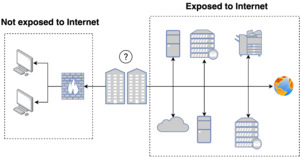



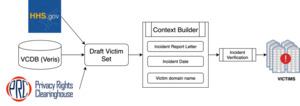

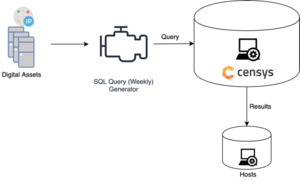


_and_*x_o_*_(right).jpg)




_.png)

_dns__(b)_.png)

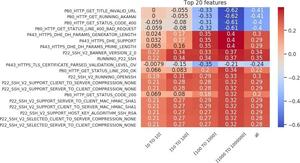








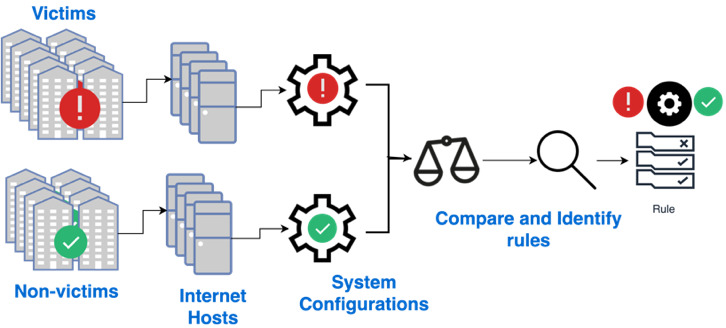



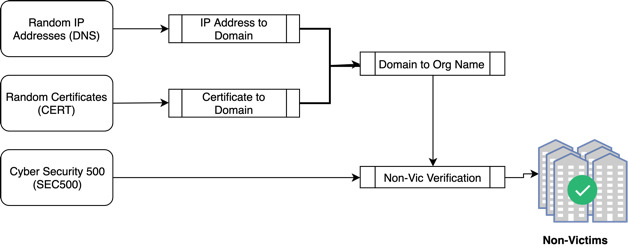


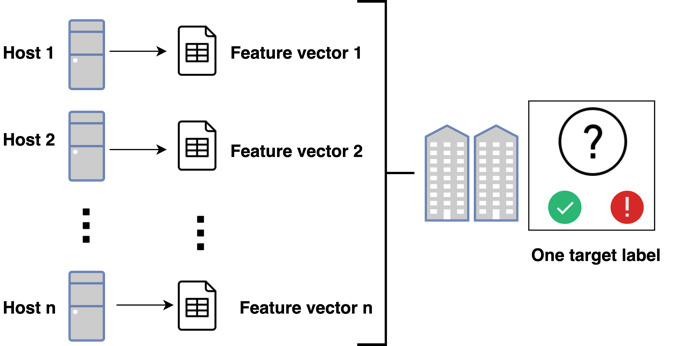
_and_*x_o_*_(right).jpg)




_.png)

_dns__(b)_.png)
